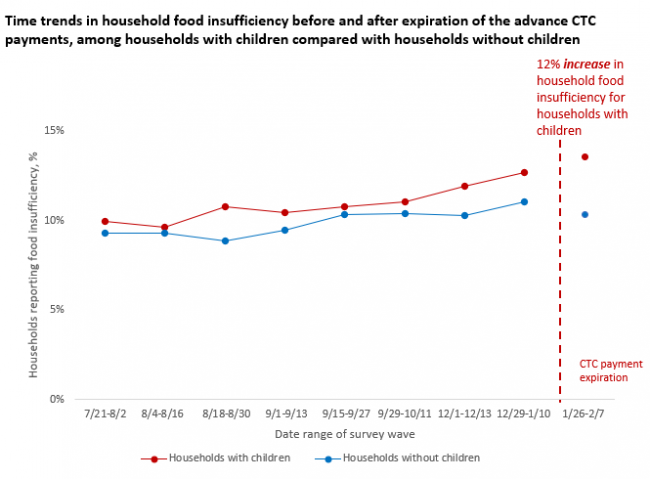Guest post: Food insufficiency in families with children increased after expiration of Child Tax Credit monthly payments
Amidst the continuing COVID-19 pandemic and increased inflation, 15% of households with children reported food insufficiency in March–April 2022. The reports of food insufficiency—sometimes or often not having enough food to eat in the past week—are from the nationally representative Household Pulse Survey (HPS), an internet survey conducted by the U.S. Census Bureau.
Food insufficiency among families with children poses a short- and long-term moral and economic threat to the United States. Even brief disruptions in access to food can have lasting consequences. Not having enough to eat often disrupts children’s cognitive and emotional development and education. This was the case for a child who disclosed that the reason she was fidgeting and not paying attention in class was that she did not have enough food to eat. There may be lifelong ramifications of not having enough to eat in childhood, including increased likelihood of poor health outcomes and avoidable medical expenditures across the lifespan.
Fortunately, Congress can help. Several studies indicate that advance Child Tax Credit (CTC) payments, expanded under the American Rescue Plan Act, were associated with reduced poverty and food insufficiency in households with children.
Advance Child Tax Credit payments
The American Rescue Plan Act included provisions for six months of advance CTC payments. The advance CTC payments were distributed as monthly cash payments of up to $300 per child to families with children under age 17 from July 2021 to December 2021. Caregivers earning less than $200,000 as a single adult or less than $400,000 as a married couple were eligible for the benefit, meaning nearly all households with children qualified.
Advance CTC payments and child health
In prior work using HPS data, we found that the advance CTC was associated with a 26% decrease in food insufficiency in households with children relative to households without children. Our findings were consistent with those of other researchers, who found that the advance CTC was associated with a 25% decline in poverty and improved dietary quality for children.
In a new pre-print using HPS data, we find expiration of the advance CTC was associated with a 12% increase in food insufficiency in households with children relative to households without children by February—and rates of food insufficiency continued to climb since February. Our findings are consistent with other analyses indicating increased child poverty following expiration of the advance CTC.

While HPS data are not directly comparable to data collected prior to the pandemic, rates of food insufficiency in March–April 2022 were about three to four times pre-pandemic levels. The HPS may underestimate food insufficiency because people without a phone or email are not included in the survey. The HPS was found to overestimate vaccination coverage but to have state estimates highly correlated with state Centers for Disease Control and Prevention (CDC) vaccine administration data. The HPS has a low response rate—typical of internet surveys—and may have limited generalizability, though the sample is useful for evaluating trends and comparing subgroups. What trend data show are increases in food insufficiency in households with children.
Other analyses indicate families with low incomes overwhelmingly used advance CTC payments on basic needs for children, including food, rent, utilities, clothing, and educational costs. There is also no evidence suggesting a reduction in employment among parents in families receiving CTC payments.
The advance CTC payments may also help address another top concern for policymakers: rising teen opioid addiction and overdose deaths. Childhood stress and poverty are associated with overdose and would be reduced with continued CTC expansion.
An opportunity for Congress to make a difference for children
As Congress turns its attention to the next reconciliation package, there is an opportunity to reinstate the expanded CTC monthly payments. Amid continued inflation, rising food insufficiency in households with children, and the COVID-19 pandemic continuing to affect work, health, and the economy, continuation of the advance CTC payments could help children avoid food insufficiency, with immediate and lifelong personal and societal benefits.
Analyses of the most recent wave of HPS data show that food insufficiency is concentrated in the lowest-income households with children. Implementing an expanded CTC without exclusions due to work or immigration status will best reach children in families with the greatest need, to the benefit of all children and society. While some policymakers have considered work requirements to receive CTC benefits, such requirements carry an administrative burden for states and families that often prevents those who most need benefits from receiving them and results in negative outcomes.
Two former Treasury Secretaries agree: Continued CTC expansion is an important investment in the nation and its children.
Enjoyed this post?
Sign up for EPI's newsletter so you never miss our research and insights on ways to make the economy work better for everyone.